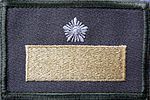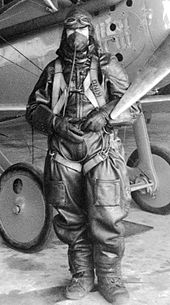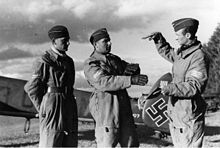Flying suit

When Flying suit ( en: suit also Flight, flightsuit or flightsuit; German language flight suit , flight suit , aviator suit , flying suit or short flight suit ), the jumpsuit designated or consisting of a uniform piece full body clothing, the pilots and crews of (military) Carry aircraft. In the NATO air force and other armed forces, it is part of the special clothing of flight crews, for example combat aircraft , gliders and helicopters . In the air force of the German armed forces this garment is officially referred to as an air service suit .
application
The flying suit should primarily protect the wearer of this special clothing from hypothermia, but at the same time be practical (with numerous pockets), useful (flame-retardant), durable, breathable and comfortable (not restrictive). As a rule, badges of rank, sovereign badges and insignia (patches) of the task force concerned are attached to military flight suits.
Notable applications of the flight suit outside of airborne combat units include Close Quarters Battle and Visit, Board, Search, and Seizure . A related item of clothing is the jumpsuit used by parachute associations .
history
The first aircraft from the early days of aviation consisted of open cockpits , so that warm clothing and sturdy shoes were imperative. Objects and documents should also be stored comfortably and securely and ready to hand on the body or in and on clothing in pockets. With increasing mobility and airspeed up to the aerobatic maneuverability of aircraft, the unwanted loss of objects that were in the uniform pockets had to be prevented.
First World War
Initially, the focus was on the invention, testing and improvement of so-called flight jackets and legwear. As early as the First World War , two-piece special clothing became standard for pilots, whereby the icy propeller airflow and the cold air with increasing flight altitudes, with decreasing air pressure and decreasing oxygen supply in the air had to be counteracted. Leather quickly established itself as the preferred material because it was hard-wearing and also offered protection from foreign bodies such as insects that hit the pilot during descent and landing. Leather clothing also offered protection against flying oil particles that escaped from the still largely exposed and simple aircraft engines and were hurled in the direction of the pilot.
The solution to the problem was achieved in 1917 by the Australian aviation pioneer Sidney Cotton , after experimenting with suitable cotton materials at low temperatures at higher altitudes. The then revolutionary new Sidcot suit was created , a suit that offered the pilot sufficient thermal protection in the open cockpit. This improved variant of the flying suit was used by the Royal Air Force until the 1950s.
Second World War
During the time of the Second World War , full body clothing was intensively developed. The company Lion-Vallen Industries , in cooperation with General Electric, brought clothing for the crews of bombers and patrol aircraft to the market, which even then operated at altitudes above the 30,000- foot limit. There can be such low air temperatures that any metal contact with unprotected body or skin areas immediately leads to frostbite.
With the introduction of pressurized cabins , the need for down and sheepskin-lined flight jackets and trousers decreased. Pilots, flight navigators and bombardiers of B-17 bombers, which were used in Europe until 1944 , wore their service uniform under the A-2 flight jacket, as this type of aircraft already had a closed and heated pressurized cabin. However, the gunmen still needed heated suits, as the guns were fired from open arms.
When the B-29 Superfortress was deployed against Japan, special thermal protective clothing, even for gunners, was superfluous due to new types of unmanned weapons that could be remotely controlled from the heated cockpit.
While the bomber crew could from then on wear the air force uniform as a flight suit, fighter pilots needed a special uniform that could be used in the narrow and narrow cockpit of a fighter aircraft . As a result, the AN-S-31 flying suit was developed for the US Army Air Corps . This had two deep chest pockets and two deep leg pockets, which the pilot could reach even when seated. The US Navy used a similar model that had slanted pockets with zippers. The material used was wool or tightly woven cotton fabrics, which were flame retardant and wind resistant.
Even at the beginning of the war, protection against burn injuries was achieved, albeit briefly. With advancing technical development, flame-retardant flying suits, pilot helmets, protective goggles, face masks, gloves and footwear were created. For example, the footwear was deliberately adapted to fashion in the civil sector, so that the crews affected should be less noticeable after a crash or an emergency landing. Bullet-proof Vests have also been developed, which for bomber crews better protection against flak - shrapnel could be achieved.
The introduction of high-speed jet fighter aircraft led to the development of the anti-g-suit : with chambers in the leg area, which can be inflated or filled with water if necessary, they support the pilot's blood circulation during flight maneuvers with high g-loads so that the blood does not get into the lower extremities sag and the brain becomes underserved (with potentially fatal consequences).
Flights at very high altitudes (from approx. 18,000 meters, where the external pressure is no longer sufficient for the use of oxygen masks ), as became possible in the 1950s, required the development of the pressure suit . This pressure-tight suit completely encloses the pilot's body and is inflated so that the wearer is adequately supplied with oxygen and the boiling point of body fluids does not drop to body temperature (~ 37 ° C). The space suit for use in space was finally created through further development .
Air forces of the NVA

For pilots of the air force of the NVA a "blue pilot combination" from national production was introduced and used as a flying suit until 1990. The aviator combination of the 1960s was also known as the "bone sack" in aviator jargon. The relevant badge in the form of a patch was attached to the left upper arm / left side of the chest. For safety reasons, military pilots of supersonic fighter planes also wore a pressure suit.
Current standards
Flying suits made from spun aramid fibers (brand name) are currently in use for the air force and naval aviation . These materials are lightweight and fire retardant. Because of their fire-retardant properties, these materials are indispensable for protecting against fire for crews of military aircraft. Preferred colors are olive green to desert yellow brown, and flying suits also contain numerous pockets (also waterproof and with cling film) and storage options for essential items of equipment (e.g. emergency radio, life jacket ) through to map materials and your own records, as well as documents relating to the mission or the mission (planned flight route, Mission order etc.). However, the color and cut can vary from country to country depending on the requirements of the application. For example, the U.S. Forces use the standard flying-suit model CWU 27 / P , which is available in sage green and sand colors. Flying suits for civil applications are available on the open market (but made from a cotton-polyester blend), which are often used by aerobatics, helicopter crews, and SAR flying personnel, including flight engineers and medical personnel.
The helicopter squadrons of the state police wear flying suits that are modeled on those of the Bundeswehr.
Spaceflight
The first NASA astronauts wore full-body flight suits during ground training and on Northrop T-38 training flights. At present, practical and comfortable royal blue and light blue flying suits made from Nomex materials are used. The orange flying suits are primarily intended to make the astronauts easier to find.
- Further examples
Fighter pilot equipment of the Swiss Air Force with flight suit
Pressure suit for U-2 pilots
Literature and Sources
- Jon A. Maguire: Gear Up! Flight Clothing & Equipment of USAAF Airmen in World War II. Schiffer, Atglen PA 1995, ISBN 0-88740-744-7 .
- Mick J. Prodger: Air Force vs. RAF. Flying Clothing of the Air War, 1939-45. Schiffer Publishing, Atglen PA 1997, ISBN 0-7643-0234-5 ( Schiffer Military - Aviation History ), ( Schiffer Military History ).
- Gordon L. Rottman : US Army Air Force. Volume 1-2. Osprey Publishing, London 1993-1994, ISBN 1-85532-295-1 (Vol. 1), ISBN 1-85532-339-7 (Vol. 2), ( Osprey Elite Series 46 + 51).
See also
Web links
- Comprehensive presentation of pressure suits for aerospace in the Encyclopedia Astronautica (English)
- Explanations of flight physiological problems on Pilotfriend.com (English)
Individual evidence
- ↑ Der Große Murat-Sanders, Langenscheidts Encyclopedic Dictionary, German-English. Volume 1: AK. 9th edition. 2002, ISBN 3-468-01124-5 , p. 583.
- ↑ Uniforms ( Memento from June 29, 2011 in the Internet Archive ) - information brochure of the Federal Ministry of Defense PDF, 1.5 MB, accessed on November 5, 2012.
- ↑ Sidney Cotton and His Colossal Lockheeds
- ↑ Sidcot Flying Suit ( Memento from April 8, 2016 in the Internet Archive )
- ↑ "Fliegergeschichten - From takeoff to landing", facts and experiences - written down by members of the NVA aviation forces, Strausberg 2013, original edition (p. 309): ISBN 978-3-9814822-3-2 , Strausberg, Berlin, 2013.







